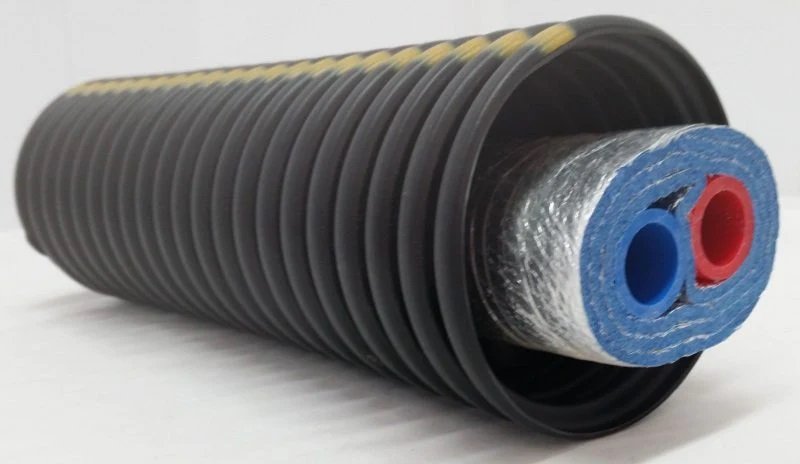Nowadays, with more and more technology being invented that helps us in our lives, it’s often difficult for these tools to find use outside their original area of expertise. The insulated tube is such a tool – an ingenious invention made possible by the smartphone era. This article discusses how you can make use of this modern-day lifesaver to install insulated PEX tubing in your outdoor wood heater.
What Do Insulated PEX Tubing and Wood Boiler PEX Pipes Look Like?
Insulated PEX tubing comes in many different shapes and sizes dependent on the application. Most commonly, insulated PEX tubing is seen in the form of pipe or tubing used for outdoor wood heaters.
A PEX pipe is made from a thermoplastic extruded pipe that has been sheathed in a polyurethane insulation layer. This layer provides thermal protection for the pipe against the weather, as well as sound and water resistance.

The go-to product for most outdoor wood heaters is 6/4 PEX (pipe strength of 6 British pounds per square inch). This tubing is made to standard specifications and has a variety of fittings available to accommodate most configurations.
The fittings are designed with thermal resistance in mind, ensuring that heat is efficiently transferred from the wood boiler to the outside environment. For applications where greater strength is required, 10/8 PEX (10 British pounds per square inch) exists.
Also Read: Find the Ideal Fireplace Heater: The Heart of the Home
How to Install Insulated PEX Tubing for Outdoor Wood Furnaces?
Insulated PEX tubing can be a great option for your outdoor wood furnace. This tubing is made of PEX, which is a type of plastic, and it is insulated. This means that the tubing will keep your wood warm and protected from the elements. Choose your installation location carefully.
Make sure that you are out of the way of anything that could fall off the furnace or get thrown into it by the wind. And make sure that the location you choose is level so that the tubing will stay in place. Measure the height and width of the tube you want to use, and multiply those numbers by two. That will give you the length of the tube you’ll need.
Remove any plants or debris from around the area where you’re going to install the tube, and clean up any debris that may have fallen onto the ground during the installation process. Dig a hole large enough to accommodate both the tube and the furnace itself.
Tip: If you’re using an offset wood furnace, make sure that your hole is dug lower than where your furnace sits. This will help keep the cold better centered in the tube, and it’ll provide resistance.
Cut a length of pipe equal to whatever measurement you took in Step 2, plus an extra foot (you can leave this extra inch or two). Soak the eight inches of pipe in water overnight. Unravel the second foot of tubing from the spool and transfer it to a new spool, then feed that into the pipe you just installed.
You might need to support one end with some blocks on top of a board or posts of some kind so that it does not fall over when being bent over after installation.
What Are the Pros and Cons of a PEX Installation?
Installing PEX Tubing to your outdoor wood heater is a great option for those that want both insulation and convenience.
Pros of using PEX tubing include:
• Weatherproofness – Since the tubing is made from rubber, it can withstand weather conditions such as rain, sleet, and snow.
• Ease of Use — Because PEX Tubing is so easy to put in place, you won’t have to spend hours locating the right fittings or struggling with stubborn screws.
• Reduced Installation Time – PEX Tubing is often installed in just a few minutes, making it a quick and hassle-free solution for your outdoor wood heater.
However, there are some potential cons to consider when installing PEX Tubing:
• Limited Sound Transmission – The tight weave of PEX Tubing inhibits sound transmission, meaning that your outdoor wood heater will likely be quieter than traditional pipe installations.
• Compatibility Issues – Because PEX Tubing is CertiPEX®, it may not be compatible with other components in your garden or homes, such as waterlines or electrical networks.
What Pre-insulated PEX Tubing Options Are There?
There are a few options for pre-insulated PEX tubing when installing an outdoor wood heater. One option is to use rigid foam insulation, which is available in a variety of thicknesses and lengths. Another option is to use extruded polystyrene (XPS), which is more expensive insulation but also offers cut-to-fit capabilities.

Insulating PEX tubing can also be purchased as pre-cut pieces that are ready to install. In this case, all you need to do is connect the tubing to the base of the wood heater, and then seal the connections with an appropriate sealant.
How Long Should You Insulate Your Boiler Tubing Yourself?
If you’re like most folks, you might be wondering how long you should insulate your tubing in order to maximize the thermal performance of your outdoor wood heater. The simple answer is that it depends. Factors such as the specific make and model of your wood heater and the surrounding climate will dictate how much insulation is necessary. In general, however, insulating your tubing for a minimum of 30 feet should provide adequate protection against winter weather conditions.















